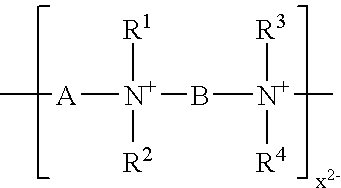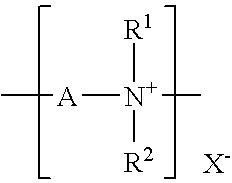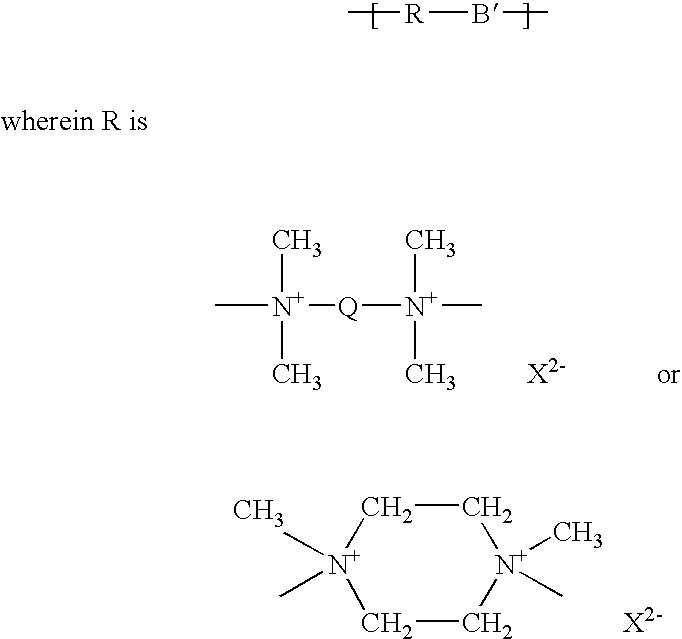Methods to reduce organic impurity levels in polymers and products made therefrom
a technology of organic impurities and polymers, applied in the field of polymers, can solve the problems of biological fouling, process operations, and a persistent nuisance or problem, and achieve the effect of avoiding time-consuming and/or energy-consuming costs and low moistur
- Summary
- Abstract
- Description
- Claims
- Application Information
AI Technical Summary
Benefits of technology
Problems solved by technology
Method used
Image
Examples
example 1
[0101] 500 ml of WSCP® polymer (plant grade), 100 ml of 36% ammonia, and 25 g of decolorizing carbon were charged to a 2 L 3 neck flask, with mechanical mixer, reflux condenser, under a nitrogen gas blanket, stopper and heating mantle. The ingredients were heated, with mixing, to reflux and continued for 1 hour. The mixture was cooled to room temperature and the carbon was removed by filter press. The filtered material was charged to a 2 L 3 neck flask with mechanical mixer and 2 stoppers, and 1 L of dry acetone was added and mixed for 30 min. The top layer was decanted and discarded. The bottom layer was poured into a suitable container and placed in a heated vacuum desscator set at 250° F., 23 in Hg until dry.
example 2
[0102] 500 ml of APCA polymer (plant grade) from Buckman Laboratories International, Inc., was charged to a 3 neck flask with mechanical mixer and 2 stoppers. 1 L of dry acetone was added and mixed for 30 min. The top layer was decanted and discarded. The bottom layer was poured into a suitable container and placed in a heated vacuum desscator set at 250° F., 23 in. Hg until dry.
example 3
[0103] 850 ml of Busang 1157 polymer (plant grade) and 1700 ml of dry acetone were charged to a 3 L 3 neck flask with mechanical mixer and 2 stoppers and mixed for 30 min. The top layer was decanted and discarded. The bottom layer was poured into a suitable container and placed in a heated vacuum desscator set at 250° F., 23 in. Hg until dry.
[0104] This method can work using any dry, polar solvent such as methanol, ethanol, isopropanol, tetrahydrofuran, acetonitrile, and the like. In practice, a great deal of effort is used to mix the ever thicker polymer, e.g., WSCP® polymer, with the solvent, and preferably washing with more than one portion of dry solvent. In a follow-up example, a much larger amount of acetone was used and mixing was done with a Cowles mixer for a long time (e.g., at least 1 hour), decanting the solvent, and repeating this procedure 3 or more times, eventually reaching 11 wt % moisture as measured by NMR.
PUM
| Property | Measurement | Unit |
|---|---|---|
| temperature | aaaaa | aaaaa |
| temperature | aaaaa | aaaaa |
| temperature | aaaaa | aaaaa |
Abstract
Description
Claims
Application Information
 Login to View More
Login to View More - R&D
- Intellectual Property
- Life Sciences
- Materials
- Tech Scout
- Unparalleled Data Quality
- Higher Quality Content
- 60% Fewer Hallucinations
Browse by: Latest US Patents, China's latest patents, Technical Efficacy Thesaurus, Application Domain, Technology Topic, Popular Technical Reports.
© 2025 PatSnap. All rights reserved.Legal|Privacy policy|Modern Slavery Act Transparency Statement|Sitemap|About US| Contact US: help@patsnap.com



